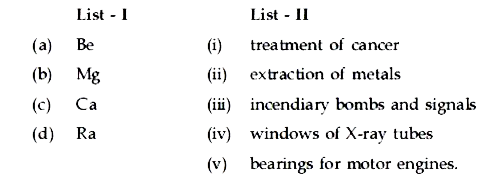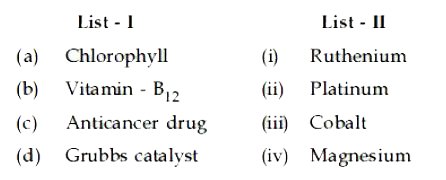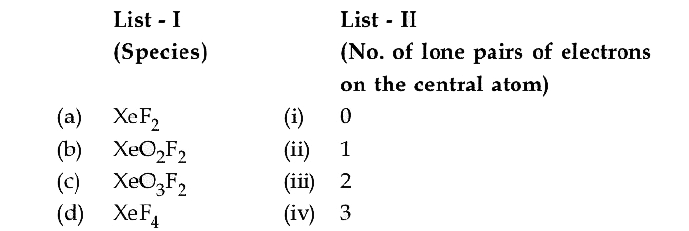Given below are two statements
Statement 1: Colourless cuprie metaborate is reduced to cuprous metaborate in a luminous flame.
Statement II : Cuprous metaborate is obtained by heating boric anhydride and copper sulphate in a non-luminous flame.
In the light of the above statements, choose the most appropriate answer from the options given below
Statement I is true but Statement II is false
Both Statement I and Statement II are false
Statement I is false but Statement. Il is true
Both Statement I and Statement II are true
The correct Answer is:B
To solve the problem, we need to analyze the two statements provided regarding cupric and cuprous metaborate.
1. Understanding Statement 1:
- The statement claims that "Colourless cupric metaborate is reduced to cuprous metaborate in a luminous flame."
- Cupric metaborate is typically blue in color, not colorless. The reduction process involves converting cupric (Cu^2+) to cuprous (Cu^+), which indeed occurs in a luminous flame, but the initial compound is incorrectly described as colorless.
2. Conclusion for Statement 1:
- Since cupric metaborate is blue, the statement is false. The correct reaction would be the reduction of blue cupric metaborate to colorless cuprous metaborate.
3. Understanding Statement 2:
- The statement claims that "Cuprous metaborate is obtained by heating boric anhydride and copper sulfate in a non-luminous flame."
- When we heat boric anhydride (B2O3) and copper sulfate (CuSO4), the expected product is cupric metaborate (CuBO2) and sulfur trioxide (SO3), not cuprous metaborate.
4. Conclusion for Statement 2:
- The statement is also false because the reaction yields cupric metaborate, not cuprous metaborate.
5. Final Conclusion:
- Both statements are false. Therefore, the most appropriate answer is that both statements are incorrect.
Final Answer:
Both Statement 1 and Statement 2 are false.
---
- The statement claims that "Colourless cupric metaborate is reduced to cuprous metaborate in a luminous flame."
- Cupric metaborate is typically blue in color, not colorless. The reduction process involves converting cupric (Cu^2+) to cuprous (Cu^+), which indeed occurs in a luminous flame, but the initial compound is incorrectly described as colorless.
- Since cupric metaborate is blue, the statement is false. The correct reaction would be the reduction of blue cupric metaborate to colorless cuprous metaborate.
- The statement claims that "Cuprous metaborate is obtained by heating boric anhydride and copper sulfate in a non-luminous flame."
- When we heat boric anhydride (B2O3) and copper sulfate (CuSO4), the expected product is cupric metaborate (CuBO2) and sulfur trioxide (SO3), not cuprous metaborate.
- The statement is also false because the reaction yields cupric metaborate, not cuprous metaborate.
- Both statements are false. Therefore, the most appropriate answer is that both statements are incorrect.
Both Statement 1 and Statement 2 are false.
Topper's Solved these Questions
- JEE MAIN 2021BOOK - JEE MAINS PREVIOUS YEARCHAPTER - JEE MAIN 2021EXERCISE - SECTION-B
50 Videos
- JEE MAIN 2021BOOK - JEE MAINS PREVIOUS YEARCHAPTER - JEE MAIN 2021EXERCISE - CHEMISTRY (SECTION-A)
20 Videos
- JEE MAIN 2021BOOK - JEE MAINS PREVIOUS YEARCHAPTER - JEE MAIN 2021EXERCISE - Chemistry (Section B)
10 Videos
- JEE MAINBOOK - JEE MAINS PREVIOUS YEARCHAPTER - JEE MAINEXERCISE - CHEMISTRY
150 Videos
- JEE MAIN 2022BOOK - JEE MAINS PREVIOUS YEARCHAPTER - JEE MAIN 2022EXERCISE - Question
561 Videos
Similar Questions
Knowledge Check
Match List - I with List- II

Choose the most appropriate answer from the options given below -A(a)→(i),(b)→(iii),(c)→(iv),(d)→(ii)B(a)→(ii),(b)→(i),(c)→(iv),(d)→(iii)C(a)→(ii),(b)→(iv),(c)→(i),(d)→(iii)D(a)→(iii),(b)→(i),(c)→(ii),(d)→(iv)
Match List -I with List-II :

Choose the most appropriate answer from the option given below:
View SolutionMatch List - I with List - II

Choose the most appropriate answer from the options given below :
View SolutionMatch list - I with List - II :

Choose the most appropriate answer from the options given below :
View SolutionMatch List - I with List -II

Choose the most appropriate answer from the options given below :
View SolutionMatch List-I with List-II :

Choose the most appropriate answer from the options given below :
View SolutionMatch List-I with List-II :

Choose the most appropriate answer from the options given below :
View SolutionMatch List -I with List -II :

Choose the most appropriate answer from the options given below :
View Solution


